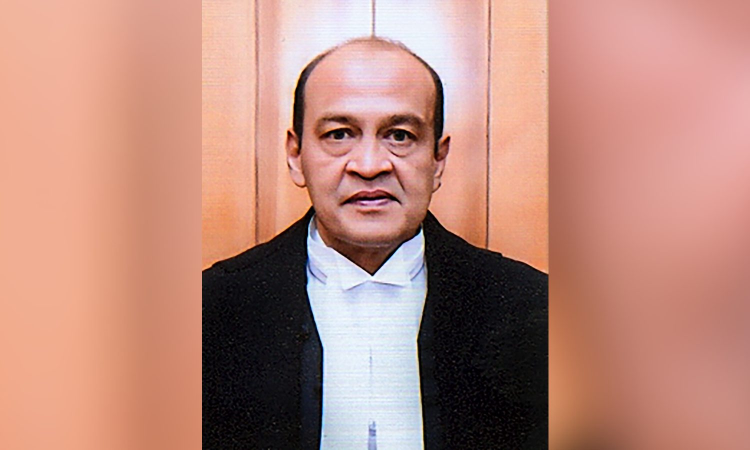Justice Varma 'in' or 'out'
Whether the saying 'A cat has nine lives' is true or not, a member of the higher judiciary certainly has more lives before he is shown the door. Ultimately, Justice Yashwant Varma's episode has made all concerned realise that there should be an effective measure to remove an erring judge from his office

Justice Yashwant Varma
CHENNAI: Justice Yashwant Varma — repatriated to his parent Allahabad High Court after a four-year stint at Delhi High Court, but denied allotment of any work — is cooling his heels in his chambers, drawing full salary and perks. Whether this will continue until his retirement in the year 2031 or whether he will be shown the door after a successful impeachment motion in the Parliament is the moot question.
Varma, as a Delhi High Court judge, was allotted a spacious government residence in the Lutyens' Delhi. He was away on a weekend vacation when he was informed there was a fire in a locked room across the servants’ quarters, and the fire service personnel who responded found bundles of currency notes. Manoj Mehlawat, an officer of the Delhi Fire Service, even exclaimed, “Mahatma Gandhi me aag lag rahi hai” (Mahatma is on flames).
When the news broke, all hell broke loose. Despite the burnt currency hurriedly removed at the instance of the judge's officers, questions arose as to why the judge kept bundles of currency in a service room and where the money came from. If that money was an ill-gotten wealth hidden by him using his official power, was he not liable to be removed from the post of a high court judge?
The removal of a high court judge while in service is not that easy. Article 217 (1)(b) states a judge may be removed from his office by the President of India in the manner provided under Article 124(4). The said Article outlines the process. A judge can be removed only after both houses of Parliament, by a specific majority, pass a resolution to address the President with a request for removal on the grounds of misbehaviour or incapacity. The resolution must be supported by a majority of the total membership of each house, and by a majority of at least two-thirds of the members present and voting.
The procedure was made so cumbersome to protect the security of the tenure of the judge so that he could fearlessly espouse the cause of justice. For the last 75 years of the existence of the system of judiciary under the Constitution, not a single judge of the Supreme Court or any of the high courts has ever been removed through this procedure. Of course, there were abortive attempts for removal, which were terminated due to the judge's resignation at the time of voting in the Parliament.
The impeachment motion moved in the Parliament will be taken up for voting only after a three-judge committee nominated by the Speaker holds a probe as per the provisions of the Judges Inquiry Act, 1963, and prima facie finds material to hold the judge of committing ‘misbehaviour’ or suffering from ‘incapacity’. Otherwise, the motion will automatically lapse, thus saving the judge from the threat of removal.
In the cases of Justice PD Dinakaran (former Sikkim HC chief justice) and Justice Saumitra Sen (former Calcutta HC judge), the committee found them prima facie guilty of misbehaviour. But, before the motion was taken up for voting, they resigned. The case of Justice V Ramasamy (former Supreme Court judge) was different. After the committee held he was guilty of misbehaviour and when the voting was announced, the Congress, at the instance of then Prime Minister PV Narasimha Rao, issued a whip asking party MPs to be present in the House, but not to press the quorum button to show their presence. This naturally made the presence of two-thirds of the members impossible. Though the impeachment motion was supported by 196 members and none against, Justice Ramasamy escaped for want of a quorum. Thus, in the annals of judicial history, not a single judge was removed from office through an impeachment motion.
It must also be interesting to note that the Constitution does not use the word ‘misconduct’ for the removal of any judge, but uses a broad connotation found in the phrase ‘misbehaviour’. In the case of Justice Varma, the question arose as to who could take action against him. After Justice Ramasamy's episode, the Supreme Court evolved an ‘in-house procedure’ to go into the complaints against sitting judges of the high courts and the Supreme Court by laying down a judicial precedent (Ravichandran Iyer 1995).
The Supreme Court suo motu took notice of the newspaper reports and constituted an in-house committee comprising three judges drawn from different courts. However, the court did not permit the registration of an FIR by the police for investigating the presence of currency notes in the house of a judge, which were burnt in a service room and were mysteriously removed. Even a petition filed in this regard was dismissed. The Supreme Court also retransferred Justice Varma to his parent Allahabad HC but clarified that he would not be assigned any judicial work. Thus, for the past few months, Justice Varma has been sitting in his chambers with no work but drawing full salary and perks attached to the office. Maybe it is a case of ‘no work, more pay’.
It was at this juncture that the chairman of the Rajya Sabha and the Vice President, Dhankhar, said that in the case of the higher judiciary, the exclusive power of removal of a judge vests only with the Parliament, and the judiciary has nothing to do with it. Meanwhile, the three-judge in-house committee submitted its report to the Chief Justice of India, who in turn forwarded the same to the President with a request to initiate an impeachment motion against Justice Varma.
Though the Modi government convened an all-party leaders' meeting to decide on it, it was unofficially told that the impeachment motion would be moved in the next session of the Parliament. While the ruling BJP is of the view that the motion can be straight away moved and, after discussion, put to vote without the constitution of a committee of judges and getting a report under the 1963 Act, the Congress stated that the law requires a fresh inquiry by the Judges Inquiry Committee. Thus, the debate for and against it continues.
Though the petition for disclosing the in-house committee report sent to the President was rejected by the Supreme Court, the report was leaked and prominently reported in the media. The committee found that the service room was controlled by the judge’s family, and during the fire, substantial currency notes were burnt, which were stealthily removed by the judge's staff. In its report, it held that “probity is the most important and indispensable attribute of a person holding judicial office and is rather the basic eligibility criterion.” However, Justice Varma asserted that the burden of proof lies with the authorities to demonstrate any wrongdoing, and he should not be expected to disprove accusations. He also challenged the fundamental fairness of the actions taken against him. Vice President Dhankhar stated that there is no answer as to how anyone can prevent an FIR from being registered against Justice Varma, because, without the nod from the CJI, no FIR can be registered against a sitting judge of a higher judiciary. Even if the impeachment motion is introduced by consensus of all parties, one cannot avoid the matter being referred to a three-judge inquiry committee constituted by the Speaker of the Parliament and only if that committee comes to a prima facie satisfaction of the charges found in the impeachment motion the further debate and voting in the House of the Parliament is possible.
Even assuming such action may follow, there is yet another Narasimha Rao factor where the final count on the quorum of the House may come into play. In this process, Justice Varma may remain in his chambers without work and repose. Whether the saying 'A cat has nine lives' is true or not, a member of the higher judiciary certainly has more lives before he is shown the door. Ultimately, Justice Yashwant Varma's episode has made all concerned realise that there should be an effective measure to remove an erring judge from his office.
— The writer is a retired judge of the Madras High Court



